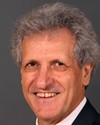Right now, if memory serves me right, if you look at Air Canada, because their regional feed is provided by Air Canada Jazz, I believe Air Canada Jazz has about 55% of the regional market. I can't recall what WestJet's is, so perhaps you may be impacting the regional feed between Quebec City and Toronto on a flight, or Quebec City and Halifax--anywhere else, I don't know.
I think the important thing to look at is not that route in terms of origin and destination but in terms of how it fits into a larger picture. So if you take a passenger from Quebec City into Toronto on high-speed rail.... Let's take that scenario for a minute--and it could be the reverse, getting into Quebec City. If you're going into Toronto, you want to make sure that the high-speed rail connectivity meshes with a larger plan, perhaps, for aviation in the GTA or elsewhere. It's not only about origin and destination point to point; it has to fit into something that makes some sense. That's why we say that at this time it's hard for us to take a stand either for or against it. We're not against it right now, but we need more information and we're asking you to look at this, as Mr. Volpe pointed out, in a larger context going forward.
We appreciate that you don't have a lot of answers either.




